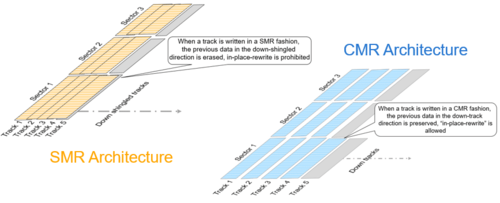We are still actively working on the spam issue.
Home Server/Shingled Magnetic Recording
Shingled Magnetic Recording (SMR) is a hard drive technology that offers a significant increase in storage density compared to traditional recording methods. The technology is named after the way roof shingles overlap. Similarly, in SMR, data tracks overlap each other, just like shingles on a roof, allowing more data to be written in the same physical space.
The technology behind SMR involves writing new tracks that overlap part of the previously written magnetic track, leaving the previous track narrower and allowing for higher track density. This is different from conventional hard drives, which write non-overlapping tracks in parallel (perpendicular recording), leaving gaps between the tracks.
However, this method of overlapping tracks means that rewriting data can be slower, as it may require rewriting adjacent tracks as well. This makes SMR technology less suitable for applications with frequent random writes. The big names in the cloud storage industry like Backblaze tend to avoid these drives.
Unfortunately, the nuances of this discussion are often lost in the homelab scene. Many people repeat the same criticisms of SMR drives ("SMR is slower" or "SMR is not suitable for NAS") without fully understanding the technology or its intended use cases. This has led to a somewhat unfair reputation for SMR drives as being universally inferior to CMR drives.
In reality, whether an SMR drive is a good choice depends on the specific use case. For certain applications (such as a home server), an SMR drive can be a perfectly fine, cost-effective solution.
